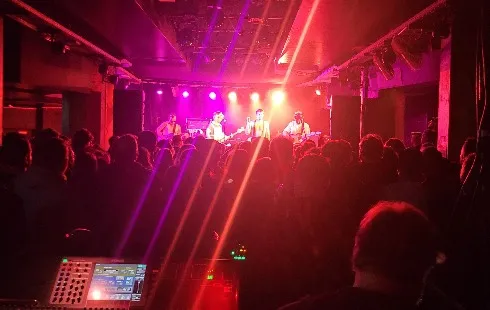
Pantone's Color of the Year an Endless Neutral Loop
Section: Fashion
Dreadlocks usually are more than just hair; they have a deep meaning for the respective person and are seen as a reference of being black. More generally: hair is one of the most important signifiers of identity. The collective artists MwangiHutter used and still use Ingrid Mwangi´s dreadlocks as part of their body art. At one point in their past it was clear that something new had to evolve and thus the hair was to be cut which involved sad feelings and was a symbolic process. Ingrid Mwangi says that cutting it was also an empowering gesture; she freed and reinvented herself by doing it. In the video project about it the audience can watch her cutting the dreads one by one and share moments when she is overwhelmed by her feelings.
These dreadlocks now make a third of a "stola" which that Saturday evening, the 14 of December in Munich was put as stack on a turntable where it was slowly making its rounds. After a while MwangiHutter got up, put this huge necklace of hair on her shoulders, stepped on the turntable and made her rounds moving the hair up and down her shoulders, her head. Displaying herself from different perspectives.
Body art always is a direct way to communicate from artist to audience and often enough it is disturbing. Voice performance even more! MwangiHutter sitting at a sofa on stage hiding her face under a hood uttering sounds and sounding like being more than one person: mumbling, shrieking, bubbling sounds for minutes.
For MwangiHutter voice art is a means of expressing how it is not to be understood, not to be able to communicate and share humour as it is when you come to a country not speaking the language.
The artists merged at one point from being two persons to seeing themselves as one unit and a fictive artistic personality as they kept asking themselves "whose idea was this, whose thought that?" and "where do I start, where do you end?". The logical step was to create one body of work.
Alanna Lockward was leading the dialogue with the artists after the performance and after watching some video works by Jaennette Ehlers, Teresa María Díaz Nerio, Tracey Moffatt and MwangiHutter. All these artistic video works vividly showed situations and sequences of racist prejudice, racist presentations in movies, the white view on the black body or the reality in poor areas where people still live a live that is normal for them.
All in all it was an interesting evening organized as part of the exhibition "Decolonize München" and it was again raising awareness even though most of the audience already knew the matter very well.

Section: Fashion

Section: News

Section: Fashion

Section: Arts

Section: Politics

Section: Health Insurance

Section: News

Section: News

Section: News

Section: Arts
Both private Health Insurance in Germany and public insurance, is often complicated to navigate, not to mention expensive. As an expat, you are required to navigate this landscape within weeks of arriving, so check our FAQ on PKV. For our guide on resources and access to agents who can give you a competitive quote, try our PKV Cost comparison tool.
Germany is famous for its medical expertise and extensive number of hospitals and clinics. See this comprehensive directory of hospitals and clinics across the country, complete with links to their websites, addresses, contact info, and specializations/services.
Join us for an enchanting Christmas adventure at the Münchner Marionettentheater! Experience the marionette play 'Der verschwundene Wunschzettel' by Siegfried Böhmke, featuring our beloved Kasperl Larifari and his little friend Stupsi. As Christmas approaches, both Kasperl and Stupsi have prepared...



No comments yet. Be the first to comment!